DENMARK

The
Achievement
|
|
|
|||
|
Achievement, 1369 Petersen 60 Emblem:
Square cross Crown: A royal crown Supporters: D.: Lion S.: Griffin L: [signetu erici dei gra re] gis et ducis pom
et c. |
||||||||||
|
Christoffer III |
*1416-†1448 King of Denmark 1440-1448 |
|||||||||
|
|
||||||||||
|
House of
Oldenburg |
||||||||||
|
|
||||||||||
|
Christian I |
1448-1481 |
|||||||||
|
Christiern 1.s sigil som Konge al Danmark, 1449. Skjoldholdere: to vildmamd. Denne og de følgende tre illustration er er taget Ira Henry Petersen: Danske kgl. Sigiller, 1917.
Secret seal of Christian I, 1449 Petersen
72 Arms: ¼: 1. Denmark; 2. Oldenburg; 3.
Gotland; 4. Sclavonia. Over all a cross Supporters: Two bearded wild men L.: Secretum Cristierni dei gra danor sclavor goto qi regis ac comitis de
oldenborch et delmenhorst
Seal of Christian I as a king of Denmark and Norway,
1450. Petersen
74 Arms: Cross and ¼ of Denmark, Norway, Goths, and
Sclavonia and i.n.p. Oldenburg Supporters: Two lions L.: Secretu cristierni dei gra
dacie norwegie sclavorum gotorum qu regis ac comitis de oldenborch et
delmenhorst
Secret seal of Christian I, 1457-‘59 Petersen 76 Christiem 1.s sigil som Konge at Danmark, Norge og Sver'ige, 1457. Skjoldholdere: en harniskkltEdt ridder og en vildmand. Arms: ¼: 1. Denmark; 2 Sweden; 3
.Norway; 4. Sclavonia. Over all a cross charged with Oldenburg Supporters: D.: A man in armour; S.: A wild man L.: Secretum Cristierni Ÿ dei Ÿ gra Ÿ dacie svecieŸŸŸŸŸ norwegie Ÿ slavorum gotoru regis ac
comitis 8 de oldeborch et Ÿ delmenhorst Ÿ
Seal of Christian I as a king of Denmark, Norway,
Sweden, Duke of Schleswig and count of Holstein. 1460 Petersen
76 Arms: ¼ Denmark, Sweden, Norway,
Sclavonia; Esc.: ¼ Schleswig & Holstein
inp Oldenburg Crown: Of five large leaves and four
small leaves Supporters: An angel and a wild man L.: Secretun
cristierni dei gra dacie svevie norvegie sclavorum gotorum que regis ducis
slesvicensis ac holsacie stormarnie oldenborch et delmenhorst comitis On this coat of arms a crown is introduced (1460) Lit.: Warming [1] |
||||||||||
|
Hans |
1483-1513 |
|||||||||
|
Secret seal of
King Hans, 1484-1512 Petersen
87 Arms: ¼ of Denmark, Sweden, Norway and Wenden, a
rimmed cross, charged with an escutcheon ¼ 1&4 Schleswig; 2&3.
Holstein. With Oldenburg in nombril point. Crown: A crown of six leaves Supporters: Two lions guardant L.: secretu iohannis dacie svecie norwegie
sclavorum gottorum regis ducis sleswicen ac holsacie stormaie et ditmarcie
ducis comitis in oldenborgh et delmenhorst |
||||||||||
|
Christian II |
*1481-†1559 1513-1523 King of Sweden 1520-1521 164st knight of the Fleece. Barcelona 1519 |
|||||||||
|
Achievement and portrait of Christian II By Lucas Cranach the Elder
1523 (MMA) Arms: ¼ of Denmark, Sweden, Norway and
Wenden, a cross Or, rimmed Gules, charged with an escutcheon ¼ 1&4
Schleswig 2. Holstein 3. Stormarn;
with Oldenburg in nombril point. Crown: Of
seven leaves Supporters: Two
wild men armed with clubs
King Christian II , crowned, with sword and orb and
his coat of arms supported by two wild men. On a woodcut, 1523 Så var det beskikket Thus it was ordained |
||||||||||
|
Frederick I |
1523-1533 |
|||||||||
|
on his seals 1524-1532 (Pet. n°s 110-113) Mit håb er Gud alene My hope is God
alone |
||||||||||
|
Christian III |
1534-1559 |
|||||||||
|
1536 W.: ¼: 1&4: Denmark; 2. Norway; 3. Wenden.
A cross over all. Escutcheon: ¼ Schleswich-Holstein-Stormarn-Oldenburg.
(Seal: Pet. n° suppl. 3) Arms: ¼: 1&4: Denmark; 2. Norway;
3. Wenden. A cross over all Argent rimmed Gules charged with an escutcheon:
¼: 1&4 Schleswich; 2 Holstein; 3 Stormarn; Esc: Oldenburg. Supporter: A lady The Dutch-Renaissance marble tomb of
Frederick I. The
marble and alabaster cenotaph is the work of Cornelius Floris of Antwerp. It
was erected in the choir of Schleswig Cathedral in 1555 and moved to its current location
in 1901. The large
sarcophagus is carried by six virtues but it is empty: Frederick I was buried
inside the church but the exact location of his remains is unknown. A
life-size reclining figure of Frederik is on to of the sarcophagus – a mirror
allows visitors to easily see the details.
Crowned arms and two small supporters. Print, 1550 Arms: Quarterly of Denmark, Norway, Sweden and king
of the Goths. Over all a cross charged with an escutcheon quarterly of Schleswig,
Holstein, Stormarn and Oldenburg. And a base of the King of the Wends. Crown: of five leaves and four pearls Supporters: Two wild men |
||||||||||
|
Ske Herrens vilje |
SPES MEA SOLUS DEUS Zu Gott mein Trost allein |
The Lord's will be done |
||||||||
|
Frederick II |
1559-1588 |
|||||||||
|
Achievenment of
Denmark by Jens Bircherod, 1581 Crowned arms supported by elephants. Arms: Quarterly of Denmark, Norway, Sweden and king of the Goths. Over all a
cross moline rimmed, charged with an escutcheon quarterly of Schleswig,
Holstein, Stormarn and Ditmarschen, ensigned with a party of Oldenbrug and
Delmenhorst. And a base of the King of the Wends. Crown: of five leaves and four pearls Supporters: Two elephants passant The arms of Ditmarschen inserted. Ditmarschen was conquered in 1559 The elephants are the emblems of the Elefantenorden founded 1462 by
Christian I.
Supported
arms in the Chapel of the Three Magi
in Roskilde Dom Guarding the tomb of Frederick II made 1594-’98 by Gert van Egen Arms: Quarterly of Denmark, Norway, Sweden and king
of the Goths. Over all a cross charged with an escutcheon quarterly of
Schleswig, Holstein, Stormarn and Ditmarschen. Ensigned of a party of
Oldenburg and Delmenhorst. And a base
of the King of the Wends. Crown: a royal crown Supporter: A standing bearded
warrior in armoury, with a spear in his right, helmeted with a helmet crested with a bird. A like warrior
facing him. |
||||||||||
|
Intet uden Gud |
DEUS REFUGIU ET FIDUSIA MEA Mein Hofnung zu Godt allein |
Nothing without God |
||||||||
|
Christian IV |
1588-1648 |
|||||||||
|
Coat of arms
attributed to Frederick II Engraving by Lauterbach, 1592 Arms: (from left
to right): Denmark, Norway, king of the Gohs, king of the Wends, Sweden,
Gotland, Schleswig, Island, over all a
rimmed cross ensigned Ditmarschen. And in base Holstein, Stormarn, Oldenburg,
Delmenhorst Crown: A crown
of three leaves and two ornaments Supporters: Two
lions, the dexter guardant In 1559 Ditmarschen was captured by Frederick II and
the Peasants republic of Ditmarschen abolished. After the
conquest Dithmarschen was divided into three parts: Duke Adolf I of
Schleswig-Holstein-Gottorf received the northern, his brother Duke John of
Schleswig-Holstein-Hadersleben the middle and King Frederick II of Denmark
the southern part. After the death of Johann in 1581 the Adolf and Friedrich
Johanns shares were divided under the Gottorfer and the royal line. Norder
and Süderdithmarschen existed henceforth as landscapes with their own
landscape administration and a governor or stadholder at the top. As the
arms by Lauterbach are ensigned with the coat of arms of Ditmarschen it is
supposed that they are the arms of Christian IV (then of the age of 15) as a
ruler of Ditmarschen. At the
same time Adolf I inserted the arms of Ditmarschen to his arms quarterly.
Anne of Denmark,
Queen of Great Britain
|
||||||||||
|
1588 – 1648 |
Fromhed styrker rigerne |
REGNA FIRMAT PIETAS |
Piety strengthens the realms |
|||||||
|
Frederick III |
1648-1670 |
|||||||||
|
1648 – 1670 |
Herren være mit forsyn |
DOMINUS PROVIDEBIT |
The Lord will be my guide |
|||||||
|
Christian V |
1670-1699 |
|||||||||
|
|
1670 – 1699 |
Med fromhed og retfærdighed |
PIETATE ET IUSTITIA |
With piety and justice |
||||||
|
Frederick IV |
1699-1730 |
|||||||||
|
1709 Arms: ¼: 1. Denmark; 2. Norway; 3.
Union of Kalmar; 4. Goths; In base:. Wenden. Over all a cros moline Argent
rimmed gules charged with an escutcheon: ¼ 1. Schleswig; 2. Holstein; 3.
Stormarn; 4. Ditmarschen. In nombril point: 1|2 Oldenburg and Delmenhorst. Crown: The
danish royal crown Order: Danebrog-Orden en Elefanten-Orden. Supporters: Two wild men supporting the crown |
||||||||||
|
Herren være min hjælper |
DOMINUS MIHI ADIUTOR |
The Lord be my aid |
||||||||
|
Christian VI |
1730-1746 |
|||||||||
|
Evangelisch Lutherse Gemeente Utrecht Hamburgerstraat 9, Utrecht
(NL) |
||||||||||
|
For Gud og folket |
DEO ET POPULO |
For God and the people |
||||||||
|
Frederick V |
1746-1766 |
|||||||||
|
Cristians Kirke
Copenhagen |
||||||||||
|
Med klogskab og standhaftighed |
PRUDENTIA ET CONSTANTIA |
By prudence and steadfastness |
||||||||
|
Christian VII |
1766-1808 |
|||||||||
|
Achievement 1772 |
||||||||||
|
Fædrelandets kærlighed er min berømmelse |
GLORIA EX AMORE PATRIÆ |
The love of the fatherland
is my reward |
||||||||
|
Frederick VI |
1808-1839 |
|||||||||
|
Achievement in Amalienborg Castle Arms: ¼: 1. Denmark; 2. Norway; 3. Union of
Kalmar; 4. Goths; 5. Schleswig 6: Wenden. Over all a cross moline Gules voided
Argent charged with an escutcheon: ¼ 1. Schleswig; 2. Stormarn; 3.
Ditmarschen. 4. Lauenburg. Ensigned: 1|2 Oldenburg and Delmenhorst. Crown: The
danish royal crown Supporters: Mars and Victoria
Medial arms as on
the royal standard at sea, 1819-1903 |
||||||||||
|
Christian VIII |
1839-1848 |
|||||||||
|
|
||||||||||
|
Frederick VII |
1848-1863 |
|||||||||
|
|
||||||||||
|
Line of Glücksburg |
||||||||||
|
|
||||||||||
|
Christian IX |
1863-1906 |
|||||||||
|
Medial
achievement 1903-1972 Herren er min hjælper The Lord is my aid |
||||||||||
|
Frederick VIII |
1906-1912 |
|||||||||
|
|
||||||||||
|
Christian X |
1912-1947 |
|||||||||
|
|
||||||||||
|
Frederick IX |
1947-1972 |
|||||||||
|
|
||||||||||
|
Margaret II |
1972- |
|||||||||
|
The Royal
Coat of Arms may be shown without the supporters and the pavilion. The
crowned Coat of Arms encircled by the collars of the orders of chivalry is
thus seen on HM The Queen’s shield in The Chapel of the Orders at
Frederiksborg Palace, as well as in the Great Seal used for Royal
Appointments and laws enacted by Parliament. The Royal
Coat of Arms is reserved for the Monarch, the Royal House and the Royal
Household. |
||||||||||
|
|
||||||||||
|
Christian V |
1670-1699 |
|||||||||
|
In order to strengthen the absolute monarchy,
a new order of nobility – countship and baronetship – was established in
1671. Irrespective of former status, anyone possessing sufficient land could
obtain the title of count, or, if he did not own quite as much land, be
content to call himself baronet. In time the title of baronet was superseded
by the title of baron, which was simultaneously introduced. Two years later
the Danish Law was issued. At the end of his reign a mantle and a
pavillion around his royal arms was
introduced Such a mantle and pavillion
was invented by the french heraldist Philippes Moreau in his Tableau des Armiories de France
(1630). It was first applied to the achievement of Louis XIII of France in
that work. In 1638 Silvester de Petra Sancta prescribed
that only kings and emperors were permitted to use pavillions around their
arms.
Coloured
medallion with larger achievement of Denmark Josias Barbette pinx.
1694 Arms: ¼: 1. Denmark; 2. Norway; 3. Union of Kalmar; 4. Goths; In base:
Wenden. Over all a cross pattée Argent rimmed Gules charged with a shield: ¼
1. Schleswig; 2. Holstein; 3. Stormarn; 4. Ditmarschen. Ensigned of 1|2
Oldenburg and Delmenhorst. Crown: The danish royal crown Orders: Dannebrog-Orden and Elefanten-Orden. Supporters: Two bearded wild men with loin clothes and laurel crowns, keeping a
club. Mantling: A crowned pavillion strewn with crowns and
a mantle Purpure lined ermine
Royal Mantle used
at the coronation of Christian V, 1671 and successive coronations (coll. Rosenberg Castle) |
||||||||||
|
Frederick IV |
1699-1730 |
|||||||||
|
|
||||||||||
|
Christian VI |
1730-1746 |
|||||||||
|
The motto PRO DEO ET POPULO added. |
||||||||||
|
Frederick V |
1746-1766 |
|||||||||
|
1762 The motto PROVIDENTIA ET CONSTANTIA added |
||||||||||
|
Christian VII |
1766-1808 |
|||||||||
|
|
||||||||||
|
Frederick VI |
1808-1839 |
|||||||||
|
The achievement of state The pavillion omitted Gud og den retfærdige sag God and the just cause |
||||||||||
|
Christian VIII |
1839-1848 |
|||||||||
|
The achievement of state The pavillion omitted Gud og fædrelandet God and the fatherland |
||||||||||
|
Frederick VII |
1848-1863 |
|||||||||
|
The royal achievement of Frederick VII with pavillion and mantle The motto DEUS MIHI ADJUTOR added Folkets kærlighed, min styrke The people's love, my strength |
||||||||||
|
Line of Glücksburg |
||||||||||
|
|
||||||||||
|
Christian IX |
1863-1906 |
|||||||||
|
Ære og
trokab for konge og modeland
Larger achievement 1819-1903 Med Gud for ære og ret With God for honour and justice |
||||||||||
|
Frederick VIII |
1906-1912 |
|||||||||
|
1903-1948 |
||||||||||
|
Christian X |
1912-1947 |
|||||||||
|
Min
Gud, min land, min ære My God, my country, my honour |
||||||||||
|
Frederick IX |
1947-1972 |
|||||||||
|
1948-1972 The arms of Island omitted Arms of the realm until 1959, thereafter
royal arms until 1972 Med Gud for Danmark With God for Denmark |
||||||||||
|
Margaret II |
1972- |
|||||||||
|
Guds hjælp, folkets kærlighed,
Danmarks styrke God's help, the people's love, Denmark's strength |
||||||||||
|
The decree reads as
follows: Bekendtgørelse om ændring i det kongelige danske våben. På
indenrigsministries derom nedlagte forestilling har Hendes Majestæt
Dronningen ved allehøjeste resolution af 5. juli 1972 bifaldet, at der
foretages folgende ændringer i det kongelige danske våben: I hovedskjoldet
ændres Dannebrogskorset ti et ved rette linier fra skjoldrand til skjoldrand
dannet hvidt kors med rede borter, hvorhos hovedskjoldets 4. felt ændres
således, at det nu kun udger ét felt, visende samme våben som 1. felt, nemlig
de tre danske løver ledsaget af ni såkaldte søblade. Midterskjoldet
udgår. Hjertesjoldet
ændres således, at det nu kun udgøét felt indeholdende samme våben som
hjerteskjoldets hidtidige 1. felt, nemlig de to rede oldenborgske bjælker i
guld felt. Våbenet
er omhængt af de to ordenskæder. Det holdes af to på en stenkonsol stående
vildmænd med egekrans om hoved og lænd samt med køller i de frandte hænder og
er omgivet af et fra en kongekrone
nedhængende våben telt. Våbenteltet
udfromes som en rød kåbe med for og
udvendig bort af hermelin og samles fortil under kronen, uden at den
ene part dækker den anden. Det opbindes på hver side ved hjælp af en guldsnor med to gulkvaster. En
i overenstmmelse med den kongelige resolution udført tegning gengivess
nedenfor
Den
kongelige resolution vil ikke i sig selv medføre, at der skal foretages
ændringer i de gengivelser af det kongelige våben, som med tidligere hjemmel
måtte være anbregt på bygninger og lignende. I tvivlstilfælde forelægges
spørsmålet for indenrignsministeriet. Indenrigministeriet,
den 16. november 1972 Egon Jensen.
. /B. Pileborg That is: Notice of change in the Royal
Danish Arms. At the Ministry of the Interior's disregarded
performance, Her Majesty the Queen, by the highest resolution 5 July 1972, welcomed the following changes
to the Royal Danish Arms: In the main shield, the Dannebrog cross is
changed to a white cross with red borders, consisting of straight lines from shield edge to shield
edge whereby the 4th shield of the main shield is changed so that it has now
only one field, showing the same arms as the 1st field, namely the three
Danish lions accompanied of nine so-called sea leaves. The middle shield is deleted. The Heart Shield is changed so that it now
only one field containing the same arms as the first Shield of the Heart
Shield to date, namely the two red Oldenburg fesses in a gold field. The arms are surrounded by the two order
collars. It is held by two wild men standing on a stone console with oak
wreaths on their heads and loins as well as with clubs in the outer hands and
surrounded by a coat of arms hanging from a royal crown. The coat of arms is unfurled like a red coat
with the lining and exterior of the hermelin and is gathered at the front
under the crown without one party covering the other. It is tied on each side
using a gold cord with two yellow tassels. A drawing made in accordance with the Royal
Resolution is reproduced below The royal resolution does not in itself
entail any changes to the reproductions of the royal arms, which may have
been placed on buildings and the like before. In case of doubt, the question
is referred to the Ministry of the Interior. Ministry of the Interior, November 16, 1972 |
||||||||||
|
The Royal Coat of Arms may be shown without the
supporters and the pavilion. The crowned Coat of Arms encircled
by the collars of the orders of chivalry is thus seen on HM The Queen’s shield in The
Chapel of the Orders at Frederiksborg Palace, as well as in the Great Seal
used for Royal Appointments and laws enacted by Parliament. Æ The Royal Arms The Royal Coat of Arms is reserved for the
Monarch, the Royal House and the Royal Household. |
||||||||||

© Hubert de Vries


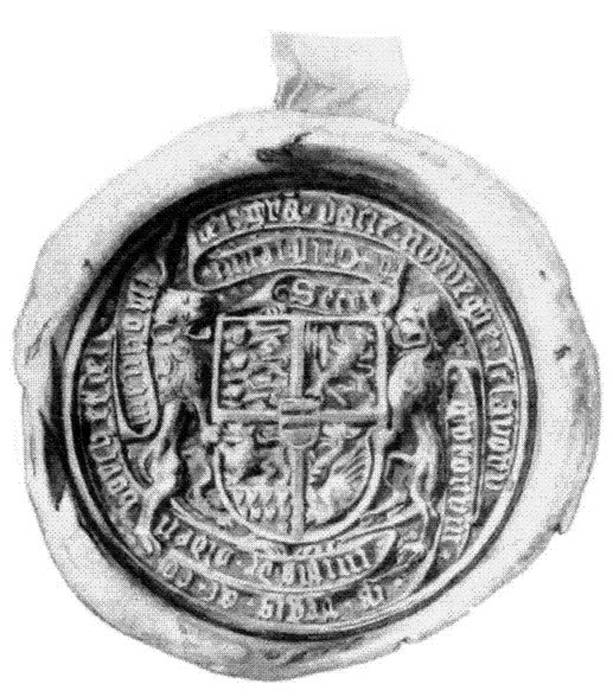
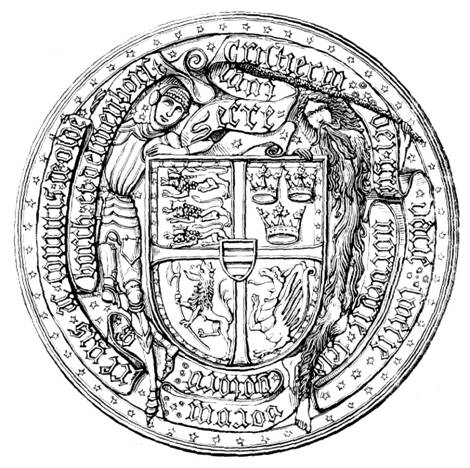


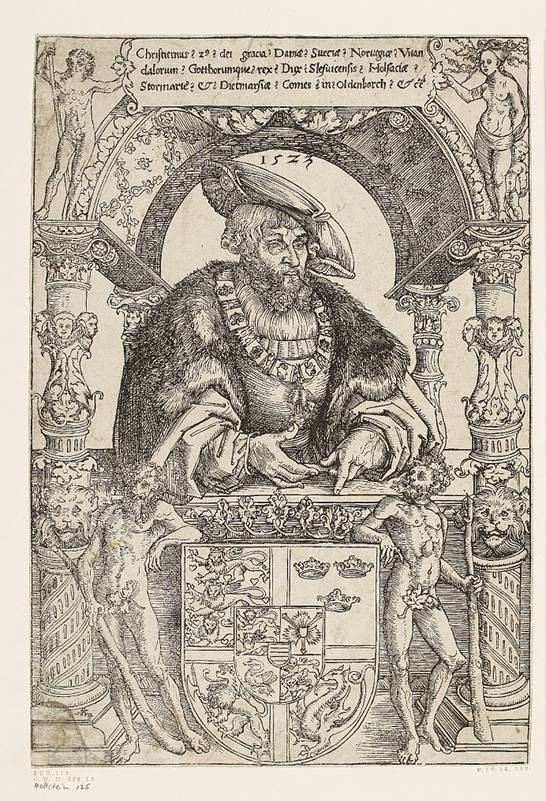
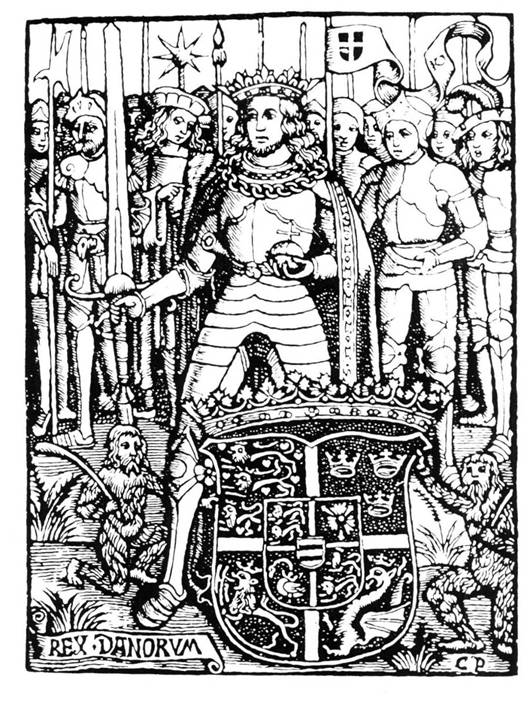
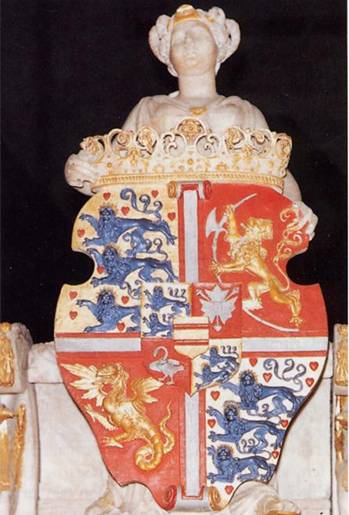
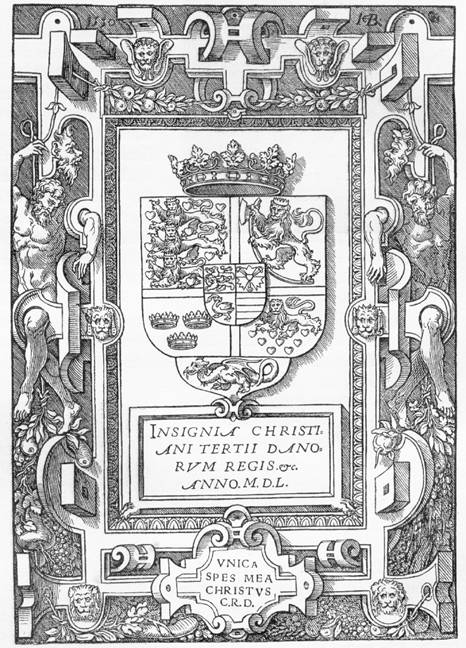
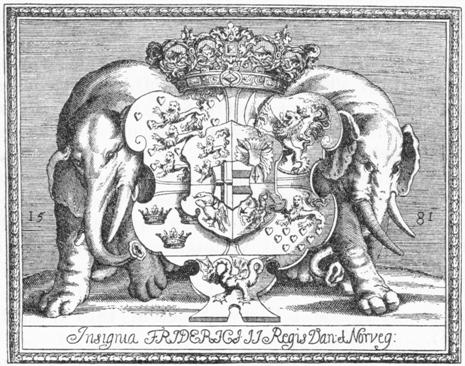
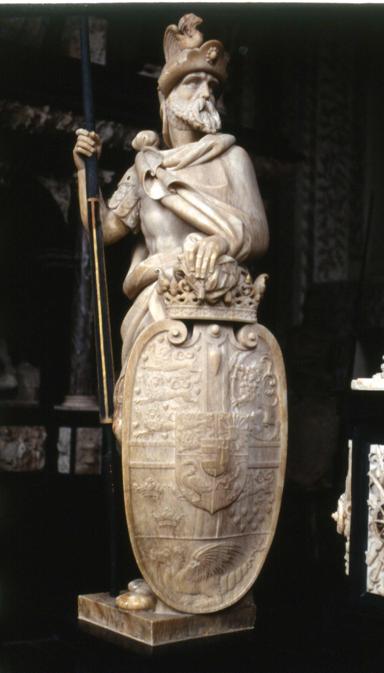
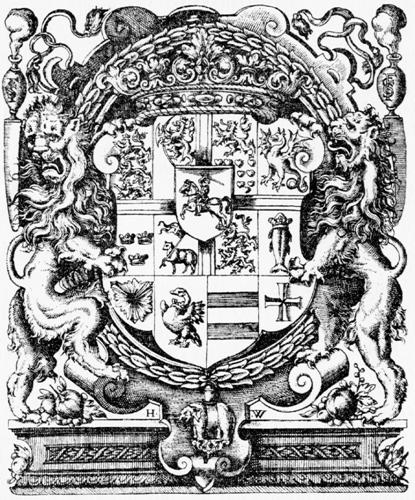
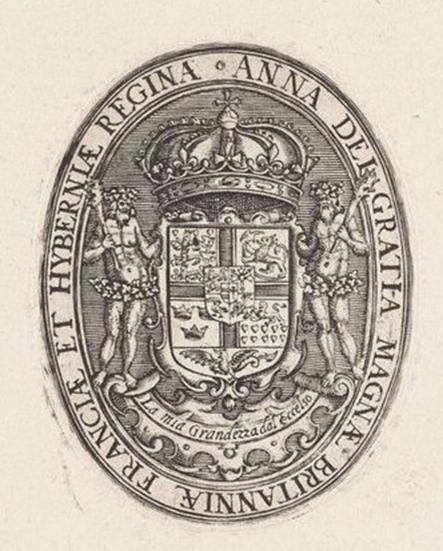
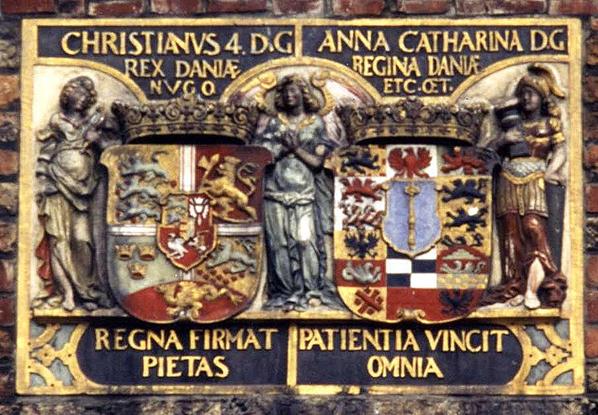
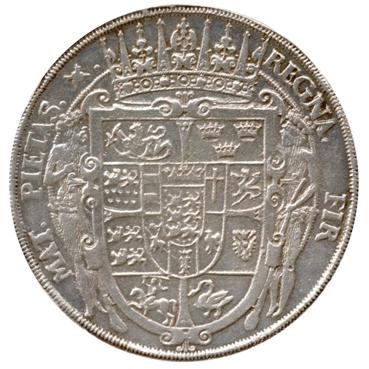
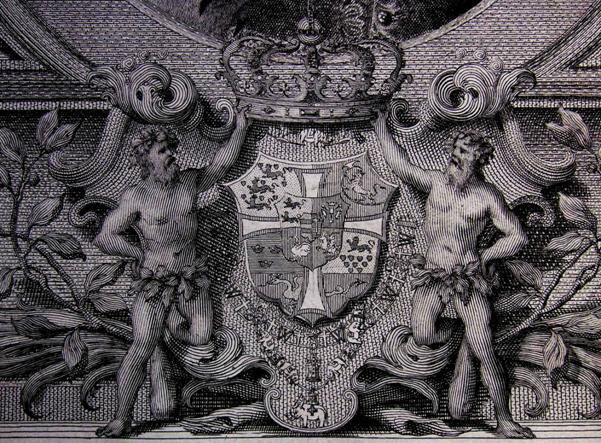
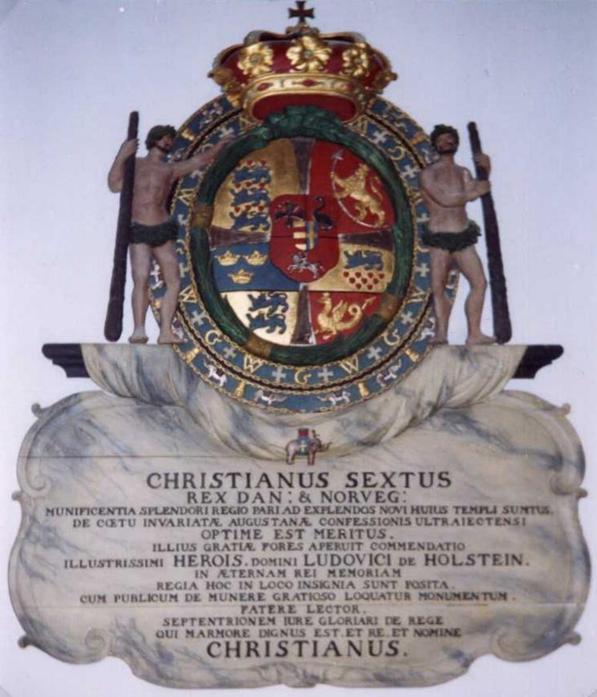
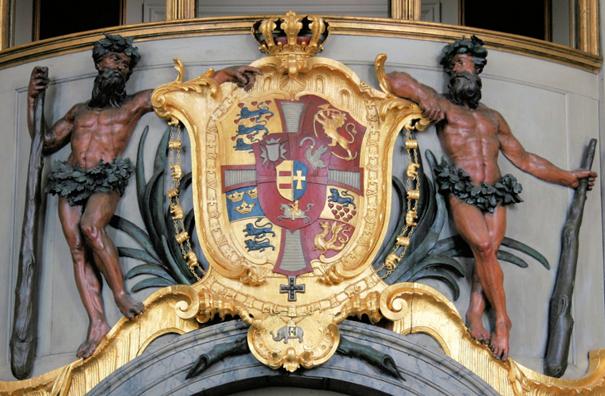
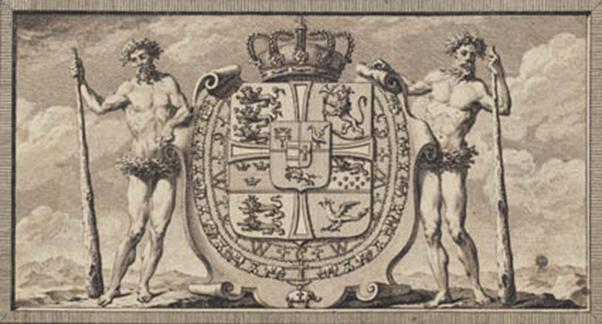
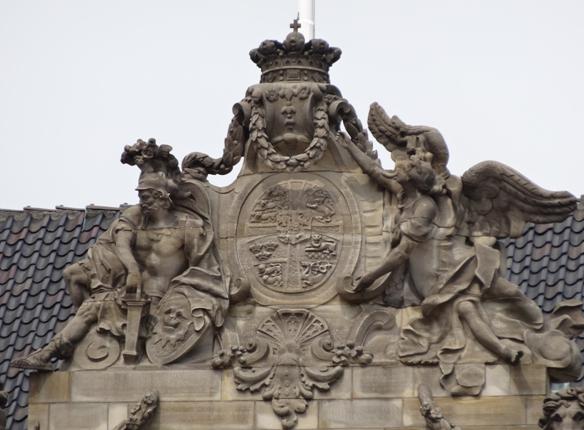
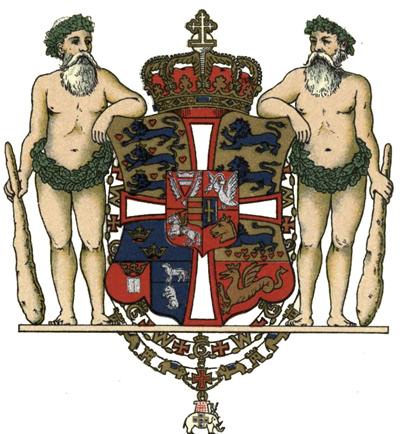

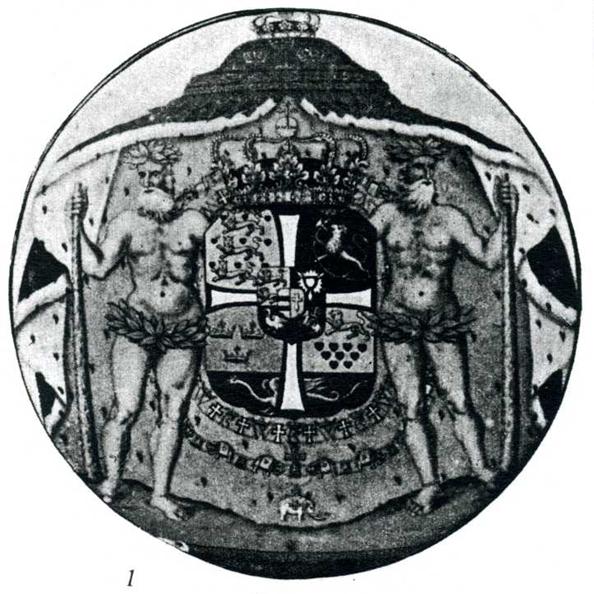
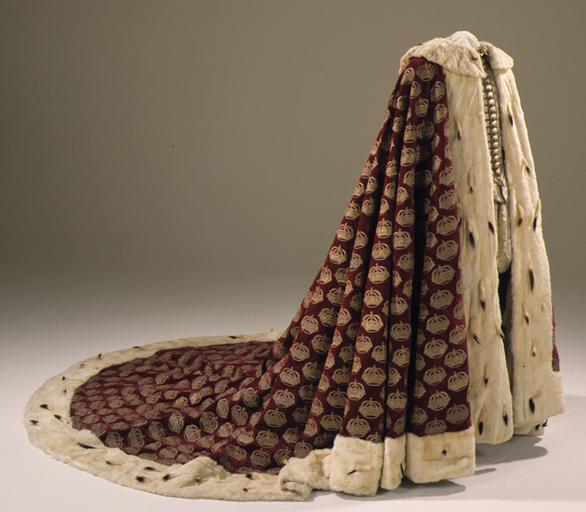

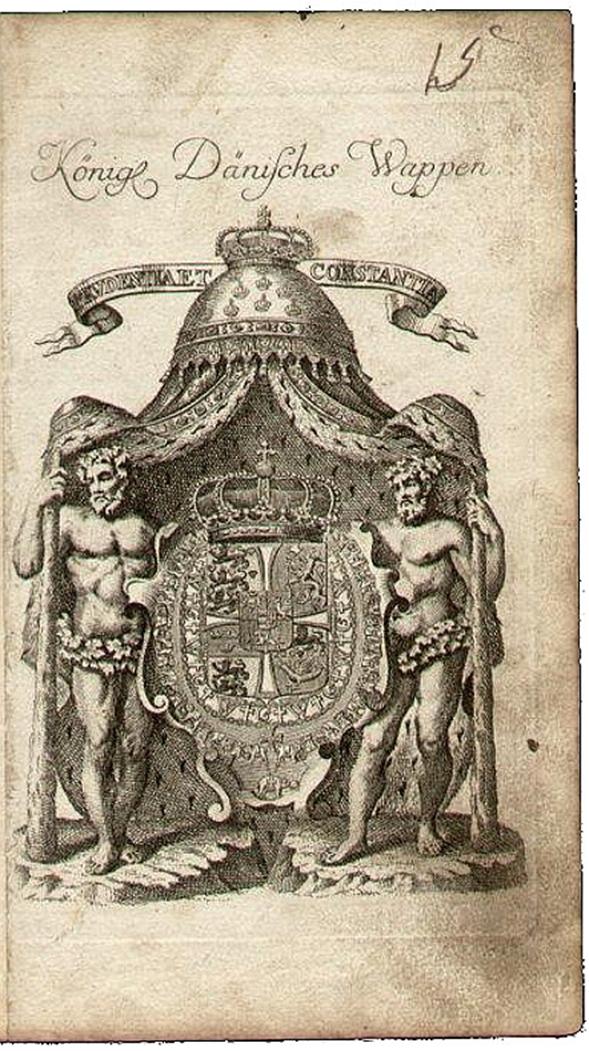
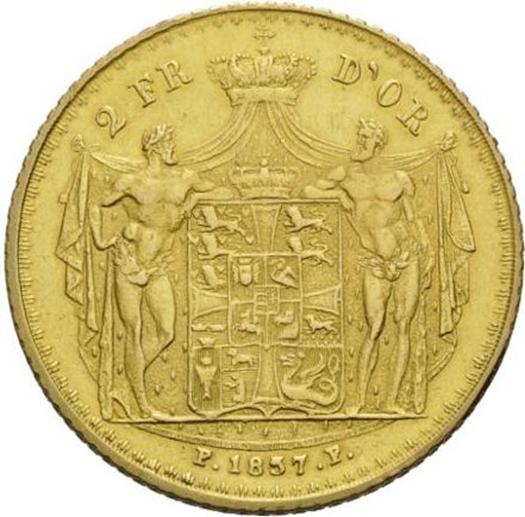
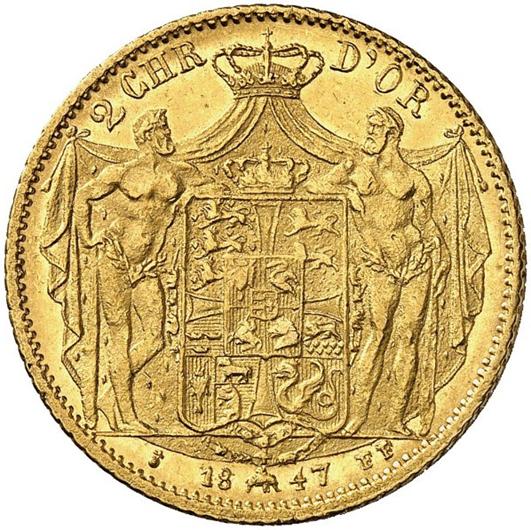
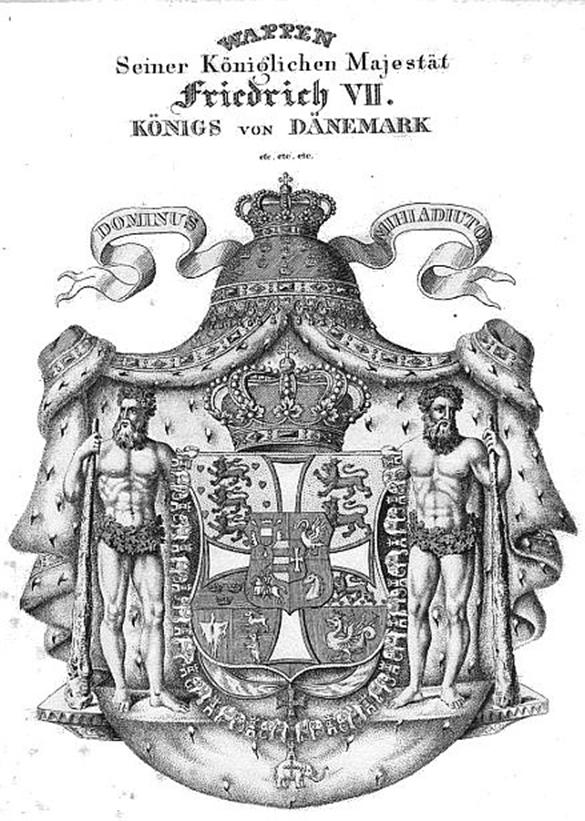
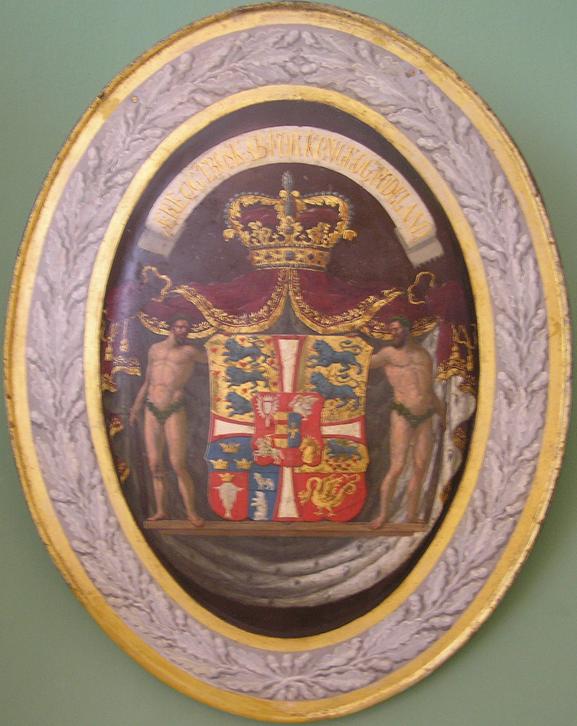
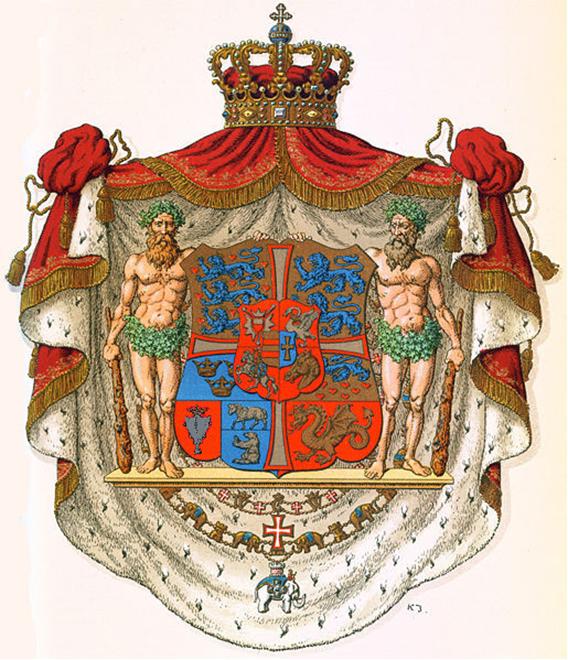
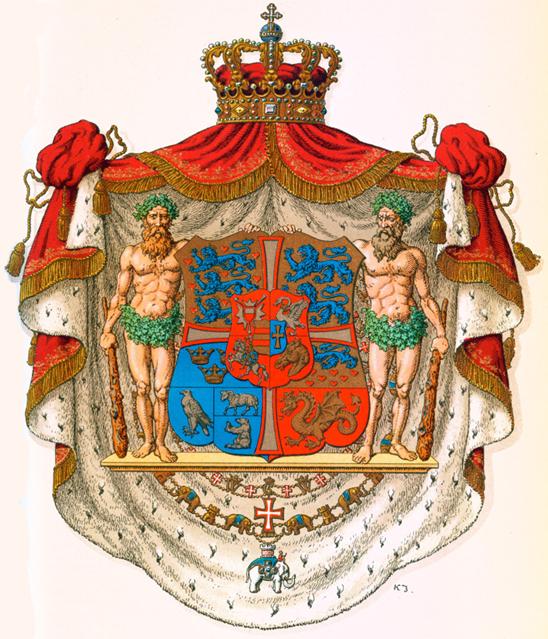
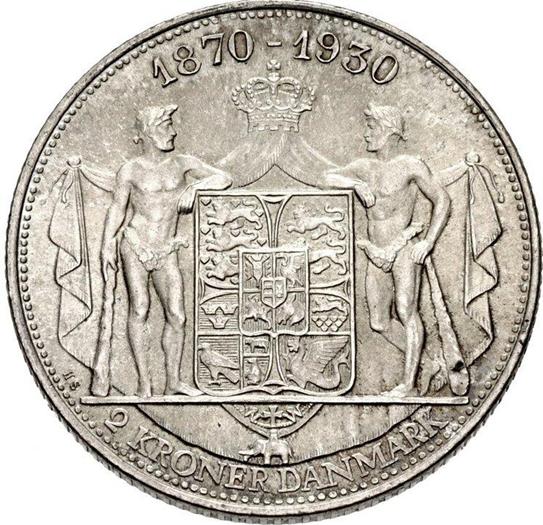
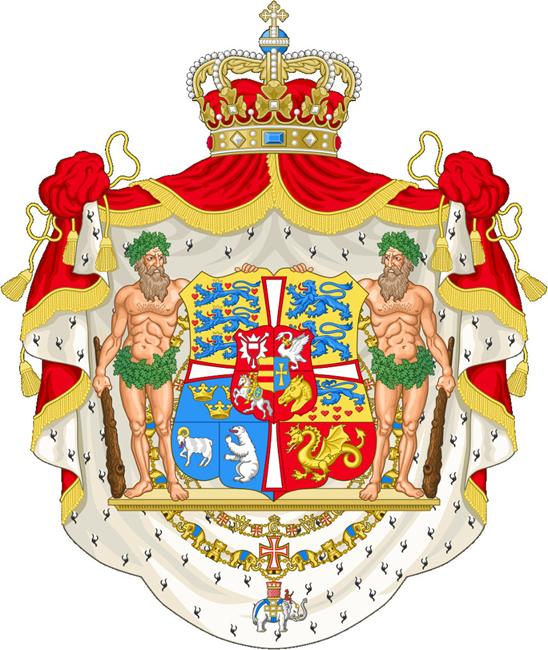
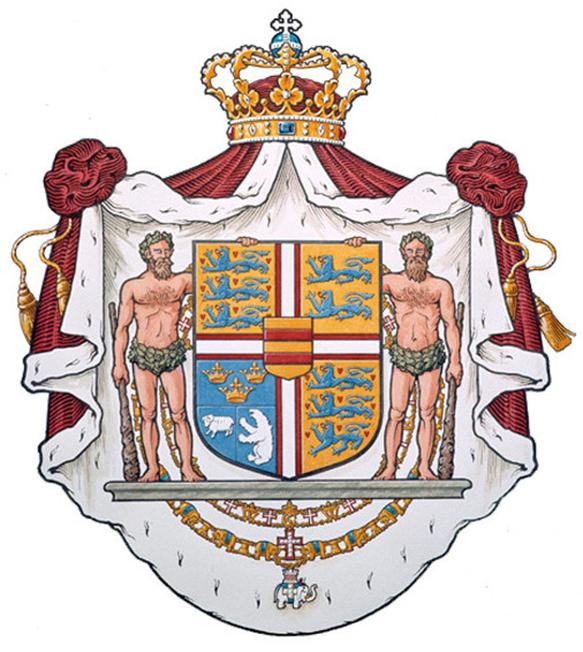
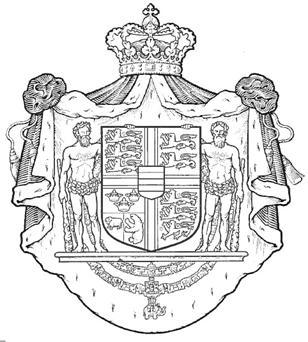
 Heraldry of the World
Heraldry of the World